Equipment
Here’s a list of what I use. You’ll notice that all the containers are stainless steel, which are of course more expensive than the polypropylene (plastic) equivalents, but I’ve learnt that it all contributes to consistent quality of what’s achievable at home!
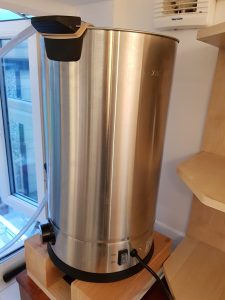 |
A Grainfather sparge water heater (Hot Liquor Tank): this heats the sparge water (‘liquor’) to a controlled temperature (usually about 77°C) and holds that temperature steady. This is an 18 litre stainless steel vessel (ample capacity for brewing 23 litres of beer), which has an electrical heater and temperature controller. The Hot Liquor Tank needs to be mounted high enough so that the sparge liquor can be delivered safely to the top of the mash bed under gravity. |
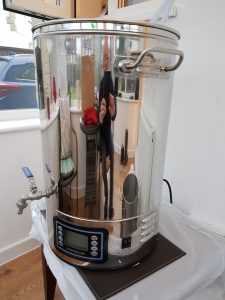 |
The Royal Catering mash tun, which is used for all of the mash, recirculation, sparge and boil stages. It consists of: a polished stainless steel kettle with an external recirculation pipe, a polished stainless steel mash container with two sieve inserts, a circulating pump and a lid made from tempered safety glass. Virtually all metal parts are made from high quality stainless steel, which are therefore ‘food grade’. It also has a built in controller to control temperature, duration of mash / boil, and can even be programmed to perform a ‘stepped’ mash where the temperature may be varied over several discrete steps. One sieve insert sits on top of the mash, the other sits at the bottom of the mash tun (the ‘false bottom’). The recirculation system allows for recirculation of the hot wort during the mash. |
 |
A pH meter. These aren’t too expensive, but are well worth using during mashing to check that the pH of the mash is exactly right. If not, this may be adjusted as explained on the water treatment page. |
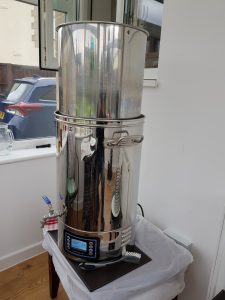 |
After mashing in the Royal Catering mash tun, the inner vessel is lifted to the top of the outer vessel, where it is supported on brackets (see photo). When this is done, the hot wort starts to drain from the mash bed and drip through the false bottom, and sparging may commence. During sparging, the top sieve (which sits on top of the mash bed) ensures that the mash bed is not disturbed. |
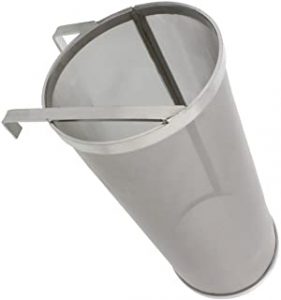 |
A hop basket. This is a really useful bit of equipment, which is used to hold the hops during the boil cycle. It’s big enough to contain even the largest amount of hops that may be called for in a recipe. Also, it’s easy to add more hops at various stages of the boil. All the left over hops are contained, and prevented from getting into the fermenter! And being made of stainless steel it’s reusable too. |
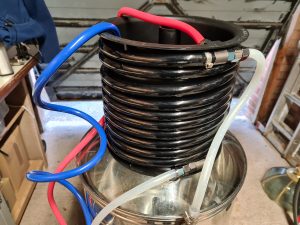 |
A counter-flow wort cooler, which is used to quickly cool down the hot wort, when the boil is complete. A counter-flow wort cooler is a tube within a tube, which is wound into a coil. The hot wort is pumped through the inner tube, while cold tap water flows through the outer tube, in the opposite direction to the wort. It’s important to cool down the hot wort quickly to reduce the risk of infections and off-flavours. If the cooled wort is fed directly from the counter-flow wort cooler into the fermenter, some of the ‘crud’ (which inevitably forms during the boil) may be transferred. When the crud is cooled, this is referred to as the ‘cold break’. It may be necessary therefore to introduce a filter. |
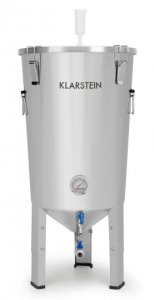 |
A Klarstein conical fermenting bin: this is made of stainless steel, with a closely fitting lid which may be clamped on, and which contains a hole for the airlock. The design of this fermenting bin is such that the fermented beer may be run straight out through the tap into the keg (or bottles), removing the need to use a syphoning tube. It achieves this due to its conical shaped bottom, where the ‘trub’ gathers. The drain tap has an inner tube which may be angled so that just the clear (hopefully) beer is drawn off. There is also a drain connected right at the bottom of the cone, which allows trub to be drained off before transferring the fermented beer into keg/bottles. It also makes cleaning easier. |
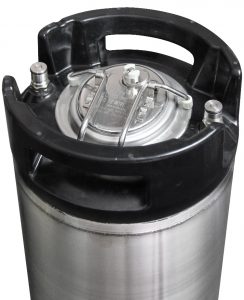 |
A Cornelius keg: This is the sort of keg that pubs use to hold, under CO2 pressure, fizzy drinks such as Coke. The Cornelius keg is ideal for kegging home brewed beer, connected to a CO2 cylinder (and pressure regulator). It holds its pressure reliably, and being stainless steel, is food-safe, durable, and easy to clean. Also, it’s possible to inject a sufficiently high pressure (about 30 psi) for forced carbonation. Cornelius kegs were originally designed to be filled using the large central opening, which is adequate for syrup but not ideal for beer, as oxygen causes the beer to degrade. Homebrewers are usually advised to purge the keg of oxygen after filling it by repeatedly pressurizing it with carbon dioxide and then venting the pressurized gas, thereby decreasing the concentration of oxygen in the headspace. A more advanced method is to perform closed transfers by first similarly purging the empty keg, and then using pressure or gravity to transfer the liquid into the keg through the “liquid out” port. The ONLY problem is that it only holds 19 litres, whereas the usual volume of a batch of home-brewed beer is 23 litres (5 gallons). I usually fill 8 bottles as well! |
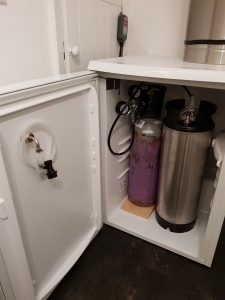 |
My ‘kegerator’. An old fridge, which holds a Corny keg and a CO2 cylinder (and regulator). And a beer tap built into the door – chilled carbonated beer on tap, wonderful! The temperature is controlled (at about 10°C for most beers) with an Inkbird temperature controller, as normal fridge temperature is too cold for beer. |
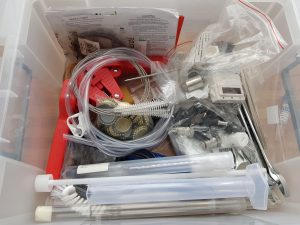 |
And all the other bits and bobs of equipment that I’ve collected – bottle capping tool, bottle caps, syphon tube, thermometer, hydrometer, cleaning brushes, spanners, corny keg spare parts etc. |
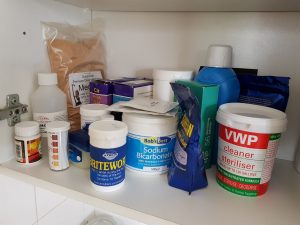 |
And not forgetting all of the essential chemicals – cleaning powder, sterilising powder, CRS, Britewort (copper finings), sodium bicarbonate, campden tablets, pH testing strips, water testing kits (alkalinity, calcium) etc. |
